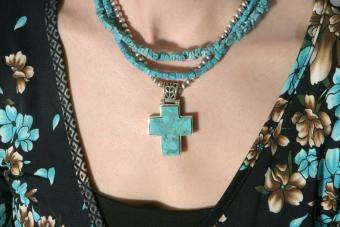
From affordable brass to precious platinum, you'll find jewelry in every metal you can imagine. Each of these materials has advantages and disadvantages, and it helps to understand a bit about the metals in jewelry before you make your next purchase.
12 Metals Used in Jewelry
Whether you're investing in fine jewelry or purchasing some costume pieces to keep up with this year's trends, you'll encounter one or more of these metals. Knowing what you're buying is important, especially if you have metal allergies or other unique needs.
Aluminum
Some costume jewelry and artisan pieces contain aluminum, either on its own or in combination with other metals. It is silver-colored and has an attractive sheen. With anodizing technology, it can be colored in bright, pretty shades.
Because of its unique properties, aluminum has several advantages when it comes to jewelry:
- According to the US Geological Survey (USGS), aluminum is very malleable, so artisans can form it into gorgeous shapes. It is often used for cuff bracelets, elaborate bib necklaces, delicate earrings, and more.
- Compared to many other options, aluminum is affordable. According to the USGS, it is the second most common metal on the planet.
- This metal is stable and does not tarnish or corrode when exposed to most daily activities. You can wear it in water.
- Aluminum is a lightweight material, making it perfect for large items like wide cuff bracelets.
It's important to note that because it is so malleable, aluminum jewelry can be fragile and prone to warping. Additionally, a very small number of people may be allergic to this metal.

Brass
Brass is a common choice for costume jewelry, since it has an attractive gold color and offers an affordable alternative to precious metals. Made from a combination of copper and zinc, the properties of brass can vary depending on the amount of these two metals used in its production. According to the Copper Development Association, the proportion of copper and zinc can also affect how jewelers can use the metal in their products.
Brass is a great jewelry metal for the following reasons:
- Brass is ideal for casting, which is creating jewelry from molds. Many costume pieces are created this way.
- It is a very strong material, which means that costume jewelry products made with brass are durable.
- Brass is extremely affordable, since it does not contain precious metals.
- In general, brass won't corrode with regular use. However, depending on the copper content, it may turn green over a long period. Unlacquered brass may require polishing from time to time, but many jewelry manufacturers apply a clear lacquer to avoid this problem.
There are a few important safety considerations when it comes to brass jewelry. Although today's brass jewelry is mostly lead free, some vintage brass pieces may contain small amounts of lead. Lead can be toxic to children and adults. Additionally, brass may also contain nickel and aluminum, so people with metal allergies may want to avoid it.

Bronze
Similar to brass, bronze is an alloy of multiple metals. Often, it contains copper, tin, and zinc. This pretty metal has a warm, brownish-gold tone that works well with a variety of stones and materials. According to Fire Mountain Gems, brass has been used for thousands of years. It has many advantages when used in costume jewelry:
- Bronze is great for detail work, so you'll find gorgeous and delicate jewelry in this material.
- It is affordable, making it ideal for inexpensive fashion pieces.
- Bronze is strong and durable.
On the downside, bronze has a tendency to tarnish or change color. Because it usually contains some nickel and aluminum, it can bother people with metal allergies. Older bronze jewelry may also contain dangerous quantities of lead.

Copper
The warm reddish glow of copper makes it a gorgeous choice for artisan jewelry, and it has a number of properties that also make it a practical option. It's a popular choice for Native American jewelry and has many advantages:
- According to the Royal Society of Chemists, copper is extremely easy to work with. It was actually the first metal worked by jewelers in ancient civilizations.
- Copper is affordable, compared to gold and silver. However, it is more costly than alloys like brass and bronze.
There are a few disadvantages to this lovely metal. Copper tends to oxidize over time, so its color will darken. Additionally, it can turn the skin green when worn for long periods. Although this is not an allergy to the metal, some people find it disconcerting.

Gold
Gold is one of the most versatile and lovely metals for jewelry. According to the American Museum of Natural History, jewelers have prized gold for centuries. There are many reasons for this top-notch status, including the following:
- Gold is incredibly malleable. Jewelers can craft it into almost any shape.
- In addition to the traditional warm yellow tone, there are actually several colors of gold.
- Gold is among the most precious and expense metals on the planet.
- Solid gold is hypoallergenic; however, some gold alloys can bother people with metal allergies.
It's important to note that most jewelry isn't created from solid gold, which is too soft. Gold comes in different karats or purities, each of which has advantages for the consumer. Additionally, because gold is such a costly metal, many pieces are gold-filled or gold-plated. This means that a layer of gold is applied over a less expensive base metal. Items that are gold-filled have a much thicker layer of gold than pieces that are gold-plated.

Niobium
Niobium is an element on the periodic table, and it is silver-colored. It accepts anodization, so niobium jewelry components come in a huge array of colors, such as blue, red, pink, and many more. According to the Royal Society of Chemists, niobium has many properties that make it useful for jewelry:
- Niobium is corrosion-resistent, which makes this type of jewelry a practical choice.
- This metal is hypoallergenic. In general, niobium jewelry won't bother people with metal allergies.
- It isn't a precious metal, so it's more affordable than gold, silver, and other choices.
- Niobium is strong. It's a component of alloys used in jet engines, oil rigs, and other industrial applications.
Niobium is common in smaller jewelry pieces like rings and earrings.

Palladium
Palladium is a white precious metal that is becoming a popular choice for jewelry. According to Gulfcoast Coin & Jewelry, there are a number of reasons to consider this metal for jewelry purchases:
- Palladium is durable, which makes it a good choice for rings and other frequently worn jewelry.
- It is more affordable than gold or platinum.
- Palladium is lighter than platinum, which means it can be used for substantial pieces.
Palladium is hypoallergenic; however, most palladium jewelry is an alloy of 95% palladium and 5% other metals. Depending on what other metals are used, allergies could be an issue for sensitive people.

Pewter
According to the Jewelry Information Place, pewter is the fourth most popular metal used in jewelry. As an alloy of tin and copper, pewter has a soft silver color. There are a number of reasons it is great for jewelry:
- Depending on the finishing process, pewter can be matte or shiny. Manufacturers can also apply chemicals to darken it for an antique appearance.
- Pewter is easy to work with and has a low melting point. This means that jewelers can craft a wide variety of detailed items from this metal.
- This is an affordable choice for costume jewelry and artisan pieces.
If you're considering pewter jewelry, there are a few potential disadvantages to keep in mind. For example, pewter can be prone to denting and damage, since it is so soft. Additionally, vintage pewter jewelry often contains lead, which is toxic. Modern and vintage pewter may bother people with metal allergies.

Platinum
As one of the most desirable jewelry metals on the planet, platinum is a popular choice for fine jewelry, including engagement rings. According to the Royal Society of Chemists, many properties give platinum its high status among jewelers and consumers:
- Platinum has a beautiful white color that does not corrode or require polishing.
- This metal is rare and very valuable.
- One of the strongest metals on the planet, platinum is excellent for jewelry that needs to last a lifetime.
- Platinum works well in many jewelry designs.
Because it is so rare, platinum is one of the most expensive choices for jewelry. Because this metal is quite soft, jewelry-grade platinum is usually an alloy of 95% platinum and 5% other metals. Depending on the other metals, this can cause problems for metal-sensitive people.

Silver
Silver is another beautiful white metal used in jewelry. According to the Berkeley.edu, silver is extremely malleable. Because it is so soft, you'll almost never encounter pure silver jewelry. Instead, you'll see sterling silver, which is 92.5% silver and 7.5% other metals.
You may also encounter silver-plated and silver-filled pieces. These items feature a layer of silver on the surface of the piece. Silver-plating creates a very thin layer, which is easily damaged. Silver-filled items are more durable, since they have a thicker layer of silver.

Stainless Steel
Stainless steel offers an affordable choice for people who love silver-toned jewelry. According to the British Stainless Steel Association, it is an alloy of chromium, nickel, titanium, copper, and other materials. There are many reasons to consider this metal for your jewelry purchases:
- Stainless steel resists corrosion. This means that it's a great choice if you'll be exposing your jewelry to chemicals and daily wear.
- Compared to precious metals, stainless steel is far less expensive.
- Stainless steel is quite durable when compared to many other metals.
- You'll find many items in stainless steel, including rings, earrings, watches, bracelets, and more.
Those with metal allergies may find stainless steel problematic. Since nickel is often included in the alloy, it's best to avoid stainless steel if you are sensitive to metals.

Titanium
Titanium is another beautiful and affordable choice. According to Zales.com, there are lots of advantages to this silver-colored metal:
- This metal is 45% lighter than steel, making it a great choice for substantial jewelry pieces.
- Titanium is durable and strong, so it's a good choice for items you plan to wear often. It doesn't bend easily, and it resists scratching and abrasion.
- Jewelry pieces crafted from titanium resist tarnishing, so you won't have to perform a lot of upkeep on these items.
- Titanium is affordable compared to precious metals like platinum and gold.
- You can purchase pure titanium jewelry or titanium alloys that contain other metals. If you have a metal sensitivity, pure titanium is a great choice.
Titanium's biggest disadvantage is that it is difficult to work. This means that it isn't easy to resize titanium rings or other size-specific pieces, and it also means that many artisan jewelers hesitate to dabble in this material.

Add Many Metals to Your Collection
Each material has pros and cons for the jewelry consumer. Experiment by adding different metals to your collection. With time and experience, you'll soon find out which metals are your favorites.







